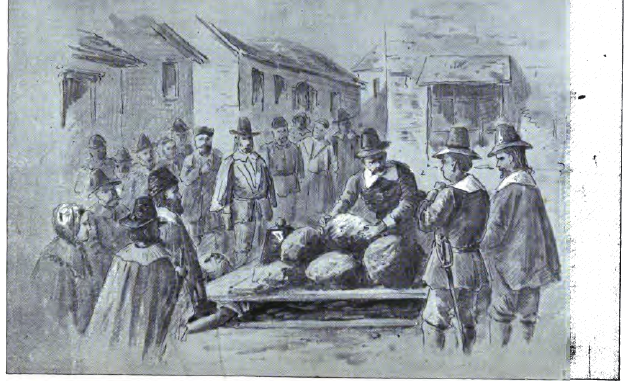
Sitting around a library computer, under the watchful eye of Ms. Mennetti, I immersed myself into the world of The Crucible. I, along with other students that did not physically attend the field trip to Salem, took a virtual field trip of Salem, Massachusetts. I found myself “standing” on the resting place of many of the characters from Arthur Miller’s famous drama.
While reading each stone’s epitaph, I came across one that I found particularly intriguing: the stone of Giles Corey. His epitaph reads:
Giles Corey
Pressed to Death
September 19, 1692
It was not what the stone said but rather what it lacked that really struck me. The scene in Miller’s The Crucible where Giles Corey is pressed make Corey seem almost saint-like–never giving in to the “pressure” to confess. His bravery and honorability are key traits that Miller wishes to portray. His epitaph however, says it so blatantly, seemingly humorous. Corey is in no way memorialized but rather disrespected in his stone’s lack of words and emotion.
After coming across this, I researched how common death by pressing. Death by pressing was most commonly used in South and Southeast Asia, not by placing heavy stones on the person by rather by being stepped on by elephants. The only instance that I could find of death by pressing in American history was Giles Corey in Salem, Massachusetts. This information shows this form of torture was so rare but the epitaph on Giles Corey’s tombstone notes this in three words, “Pressed to Death.” I find it hard to believe and difficult to fathom that three words could describe the only instance of death by pressing in American history. From the pictures that I saw online of Corey’s grave, there is no other signage explaining the importance of Giles Corey and his death.
Other than the fact that Giles Corey is the only example of death by pressing in the United States, I found his epitaph more dismissive after reading about the details of his death. In The Crucible, Miller does not say how long the event lasts, but it seems to me to be only a few hours. On one of the papers that describes all of those who died after being convicted of witchcraft, Giles Corey’s states that he “died after about 3 days of pressing.” He was tortured for three day, not counting the days when he was imprisoned, and the significance of this only deserves three words.
I realize that the stone was most likely made by those who buried him in the seventeenth century. The people who killed him would not have wanted to memorialize him. However, Salem’s main draw is its witch history, including the story of Giles Corey. Millions of dollars in revenue are being earned and many of those who wrongfully died are not properly memorialized. I would think that after this much time, there would be some type of memorial for the people killed for witchcraft. Giles Corey, a man who died wrongfully in vain, is remembered by three words:
Pressed to Death
While on the virtual tour, I was not able to find any memorial to speak of, although there very possibly is one that was not on the tour.
I would have much rathered travel to Salem than spending the day in the library at school but I feel that I was still able to experience some of the main attractions of Salem without physically being there. From what I was able to see, Salem’s rich history really comes to life in the present. I do believe that even though Salem is a tourist attraction, there should be more of a focus and respect to the stain aspects of their history.
